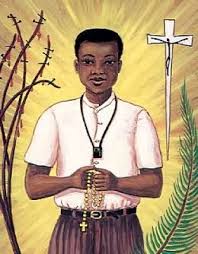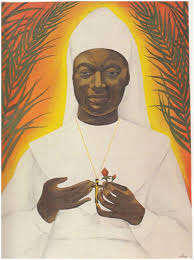SPECIFICITIES OF THE ZAIRIAN RITE VIS-À-VIS THE ROMAN RITE
The difference between the Zairian Rite and the Roman Rite is seen at different levels. While both share the same Eucharistic structure comprising the Liturgy of the Word and the Liturgy of the Eucharist, the Zairian Rite incorporates significant innovations rooted in African cultural traditions. Major differences are noticeable in the Missa Luba.
THE ROLE OF THE PRESIDER
In the Zairian liturgy, the Presider like any other liturgical celebration has the total responsibility of directing the action of the worshipping community. If the Presider in the Zairian rite is different from the Presider in other liturgies, it is because he mirrors the role of the traditional African chief. The Presider in the Zairian liturgy uses vestments that are reserved to chiefs, as his role indicates. He either wears a horsetail and goatskin hat, or wear a traditional dress made from animal’s skin (lion or leopard) and hold to symbolize his presidential role in the assembly. His role resembles the one of the Bantu chiefs as an intermediary between the visible and the invisible world, or as the canal of transmission of the supernatural forces into the earth. He carries a machete or the shepherd’s stick, which symbolizes his role as conductor of the assembly and representatives of Christ.
THE ANNOUNCER
The source of inspiration of the ministry of the announcer takes its origin from the common practice in African villages. The late Cardinal Malula puts it in these words: “the ministry of the announcer is parallel to that of the town crier in a typical African village.” The town crier in African villages, is someone chosen by the chief and the elders and is given the responsibility of calling people to take part in meetings called by the chief or the elders, for very important communications. Less important messages can be delivered by the announcer himself. For this purpose, the village crier must have a clear voice since he uses no microphone or amplifier.
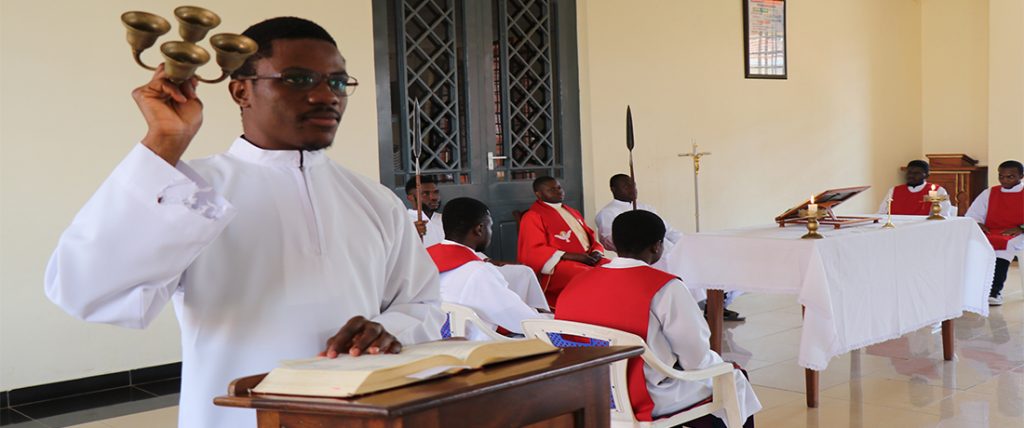
In the Zairean liturgy, the announcer plays a very important role: it is the announcer’s voice that is heard first, before the celebration starts. The announcer is chosen in the ecclesial community and among those who have abilities of public speaking. He is formed in accordance with the strategic role that he plays in the liturgy. At the beginning of the celebration and at several peak moments, he or she calls people’s attention to some events. The announcer makes his appearances to announce events such as: the beginning of the celebration, the Scripture readings, and the proclamation of the Eucharistic prayer. The announcer plays the role of what can be called a “bridge” between the priest and the assembly.
The role of the announcer as we already said, took inspiration from the African way of celebrating life, hence he operates in the same way as in the traditional celebration and uses traditional instruments, such as a Bell or Wooden Gong to make people pay attention to the messages that he has to deliver.
PRESENCE OF THE NKUMU
In the African cultural context, a leader is never alone; he is always surrounded by elders, wise counselors, and bodyguards who offer both protection and guidance. This same structure is beautifully reflected in the Zairian Rite. During the celebration of the Mass, the presider, viewed as the chief and spiritual leader of the community is accompanied by a special group of people known as the “Nkumu.” These are respected elders and wise figures within the community, often seen holding spears or symbolic knives.
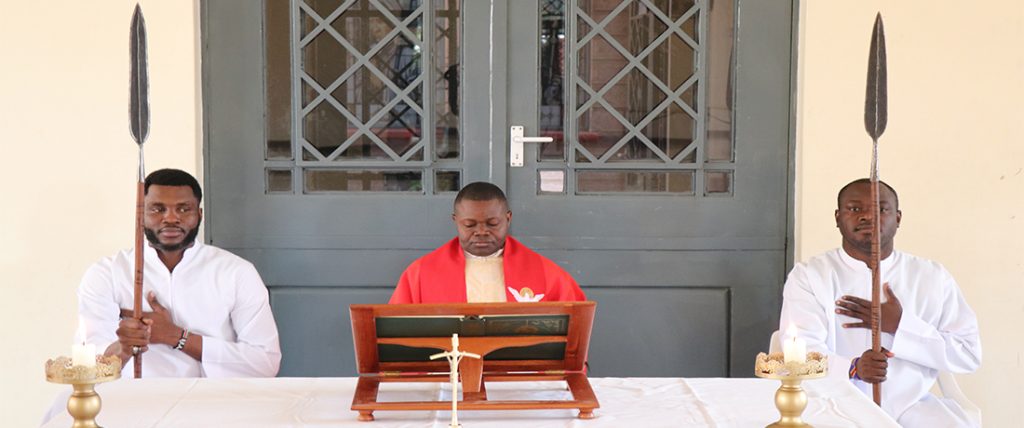
Their presence is not merely ceremonial; it carries deep meaning. The Nkumu symbolize the community’s role in protecting the presider from both physical danger and moral or spiritual temptation. They stand by the priest throughout the Mass, from the entrance procession, during the reading of the Gospel, and at other significant moments representing solidarity, support, and shared responsibility.
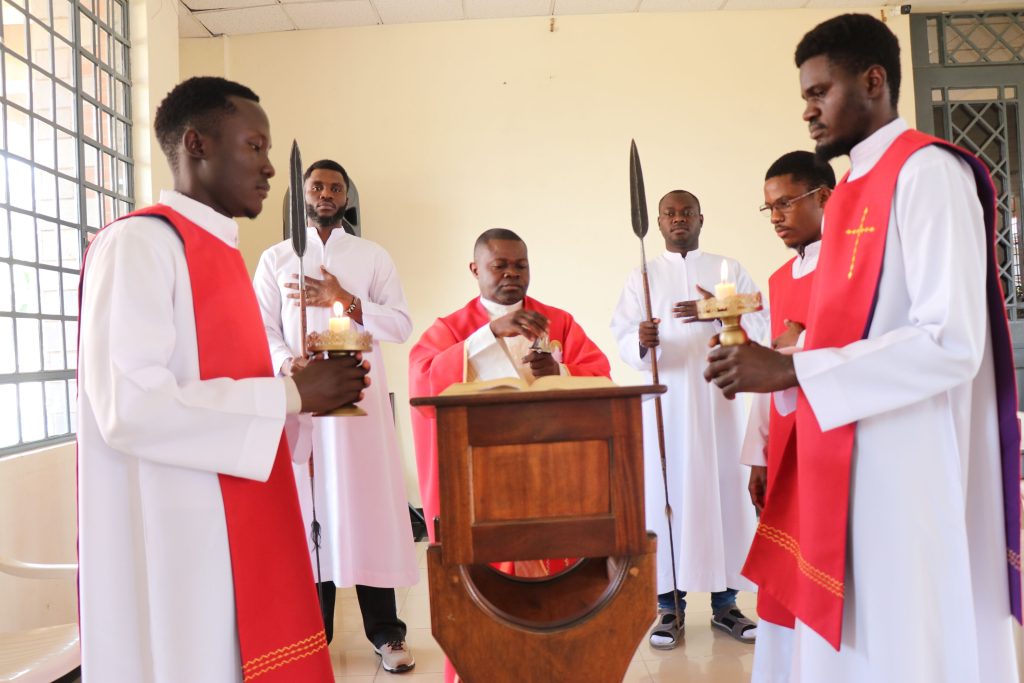
Just as an African leader relies on his council to lead wisely, the priest presiding over the Eucharist is supported by these elders, reminding the congregation that leadership in worship is not a solitary task but a communal mission, grounded in advice, protection, and unity.
THE INVOCATION OF ANCESTORS
The invocation of Ancestors refers to the invocation of Saints in other liturgies. They form one part; for the simple reason that they almost mean the same thing. What a Western Christian calls ‘saint’ is what the African Christian calls ‘ancestor’. The Invocation of ancestors has both liturgical and anthropological aspects. Placed at the beginning of Mass, it is meant to help the assembly to acknowledge its state of poverty before God and therefore calls on God’s intimate friends, the ancestors to intercede on its behalf; because as Africans, we understand God as “the God of our ancestors”.
In this way, the assembly obtains spiritual support. In the African context as defined by the late Congolese cardinal, Mosengwo Pasinya, he who is called “ancestor”, is supposed to have lived a good life on earth. Hence the ancestors were then good followers of Christ. The African is very much attached to his ancestors through whom he receives life from God. The ancestors are ipso facto the intermediaries between God and his people. The fact that the ancestors are asked to become part of the celebration shows how much they are important in people’s life.
THE PENITENTIAL RITE
The penitential rite of purification in the Roman Mass is put at beginning of the celebration, as the initial act of worship. But the Zairian Mass emphasizes the need for communion between humankind and the divine, as the first movement in worship. Then the rite of purification comes after the homily and the creed. The word of God reminds us that, sin is not divine but human; we are all sinners, and we need to ask for his forgiveness if we want to walk on his way. God is the only one who can save us from.
The placing of the penitential rite here can be understood as the support of the resolution that the assembly takes after listening to the Word of God. The Word of God has power to transform one’s life since it reveals to us that we are sinners and that it can arouse in us the motivation for our conversion. Definitely, after God has spoken to us, the penitential rite is welcome to strengthen our new strategies of life. The position of the penitential rite in the Zairian liturgy corresponds to the traditional and African rituals in which the rites of purification are performed only after certain preparatory rituals have taken place.
The reconciliation is done first of all vertically, meaning between God and his people, and then horizontally, meaning among people themselves. The sign of peace is then regarded as the conclusion of the ritual of reconciliation. It is the manifestation of the restored peace and harmony between God and people, then of the reconciliation among people. We therefore become one family and children of God, as it is said in Matt 5: 24.
MUSIC, SONG AND DANCE
The Zairean liturgy is fully influenced by the local style of singing and dancing. The Congolese are naturally musicians. The whole of human life is lived in that atmosphere; there is no area in human life, which is untouched by the power of music. The Zairian liturgy is a liturgy that is crowded with a variety of native instruments, with a uniqueness that many foreign people have witnessed. This uniqueness comes as the result of the fact that singing and dancing is fully present in the life of the Congolese people. Music is so imbedded in the being of the Congolese people that it forms an integral part of their civilization. It is here that we discover the liturgical meaning of the sacred dance. Due to its importance, there is need of saying something about the singing. For Zairian Christians, singing during the Eucharist is the manifestation of the thirst to see the Lord coming in our midst (Col 3:16). It is through singing that we show how happy our hearts are (cf. Ac 2:46), hence: “He prays twice who sings well“. There is a great need of having our singing prepared, so that we can have a well celebrated Eucharist. Dancing takes place during different moments in the Eucharist, especially from the acolytes and Bana Nkembi; and the songs are in local languages. The use of several musical instruments is also witnessed.
TRADITIONAL VESTEMENTS IN THE ZAIRIAN RITE
The use of traditional vestments gives to the Zairian Rite its mark of originality. Dressed as a traditional chief, the Presider is a symbol of a leader who is to provide food and security for those under his care. For this reason, the use of spear, knives and other traditional dresses has been introduced in the Zairian liturgy; for it is believed that the Presider who performs like a traditional chief, is a protector against devil spirits and provides spiritual nourishment for the assembly. The late Cardinal Mosengwo, one of the artisans of the Rite is convinced that the use of these traditional instruments in the Zairian Mass, have something to do with the ministerial priesthood. This means that, Christ continues to take care of his Church as a traditional chief (now Presider) takes care of those given to him by God and ancestors.
The laity also play a significant role in traditional dressing, particularly during the offertory. During this moment, those bringing offerings to the priest often wear traditional African attire.

